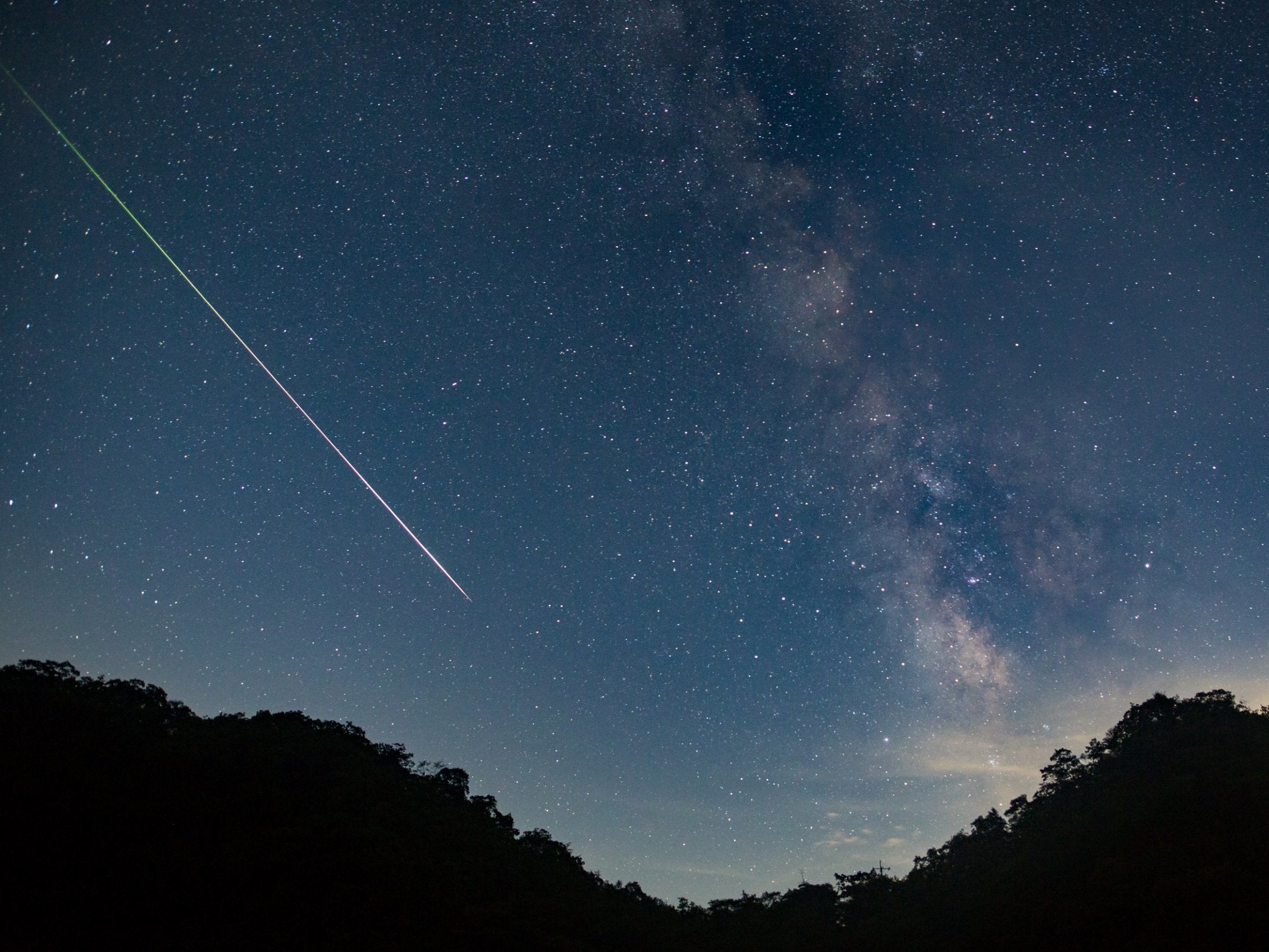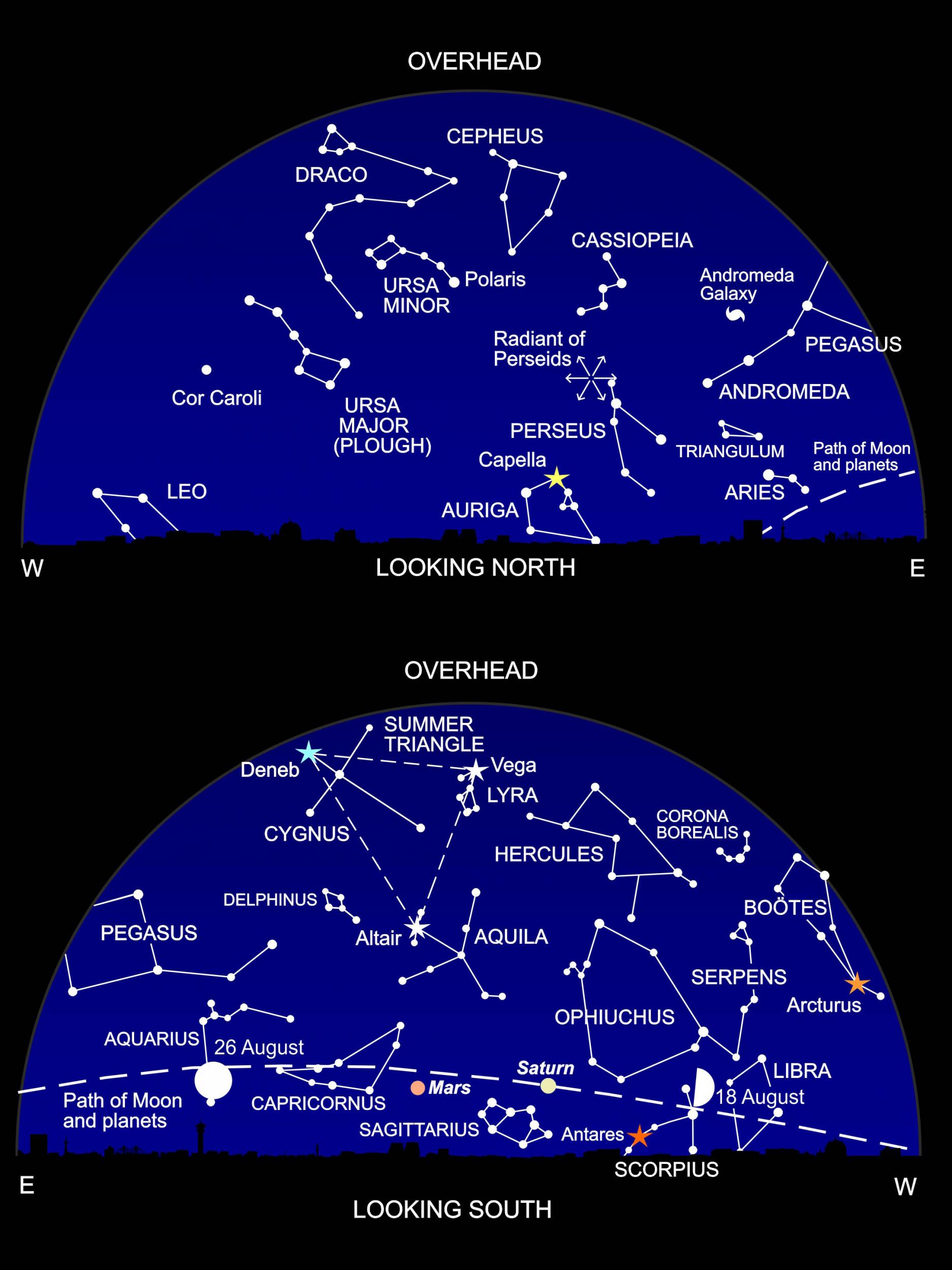Stargazing August: How to see the best meteor showers this month
The main attraction this month is the Perseid meteor shower, when you can expect to see a shooting star a minute. But there’s other celestial action in store, too

When we catch up with our pals in the autumn, they tell us about their summer break. And they rave about the shooting stars they’ve seen. "So you went on holiday at the beginning of August?" we ask. "Yes. How did you know that?" they reply.
Easy peasy. They encountered the annual Perseid meteor shower, which graces our skies on the night of 12/13 August. With the warm nights, more people gaze skywards now than at any other time of year. Meteor showers take place throughout the year. The most spectacular shower is the Geminids in December, but most of us would rather go down the pub than shiver under the winter stars.
A meteor shower is the result of the Earth ploughing through debris shed by a comet that crosses our orbit. The tiny dust particles – the size of coffee granules – stream into our atmosphere. The particles burn up at a height of around 80km, creating a bright streak in the sky as they energize the atmosphere.
Meteor showers are named from the constellation they seem to emanate from. The Perseids appear to come from Perseus; the Geminids from Gemini; but this is all a matter of perspective. Take a pair of straight lines on a motorway: in the distance, they appear to converge to a point. In the sky, this point is the "radiant" of the shooting stars – and named after the parent constellation.
More romantically, the Perseids are also known as "The Tears of St Lawrence". On 10 August AD258, a Christian deacon named Lawrence was martyred in Rome. To this day, people in Italy watch the heavens at this time of year as Lawrence’s "tears" splash down from the sky.
But back to basics: the Perseids are the solid debris of a comet called Swift-Tuttle, discovered by two independent observers in 1862. Comets are dirty snowballs; as they approach the sun, their ice evaporates to create a luminous head and a glowing gas tail; their “soot” – which makes meteors – is deposited around the solar system.
So, what can you expect to see on the night of 12/13 August? First of all, it’s a great year for seeing the Perseids. The moon’s not around, and the skies will be dark (apart from streetlights). And you don’t need any optical aid; binoculars or a telescope would limit your view.

You can expect to spot around one shooting star a minute from a dark, unobscured sky. These meteors can rival the brightest stars in the sky, but there are many fainter ones. Each one burns up in seconds. And – by the way – there’s no risk of being hit by a burning meteor, as the action takes place way up.
Our recommendation? Hold a star party. Invite your friends to relax on sun loungers, provide some inspirational beverages, point out the radiant in Perseus (on our starchart), lie down and look at the whole sky. A Perseid can appear from anywhere, but you can tell the genuine thing if you can trace its path back to the radiant.
If you’re desperate for more meteors, try observing after midnight. That’s when the dark side of the earth turns towards the incoming debris, and you’re likely to see more shooting stars.
And don’t forget: meteor showers are like cats – highly unpredictable. If the earth encounters a tight knot in the dust stream shed by a comet, you could be seeing thousands of meteors per hour. You never know. That’s the fun of a meteor shower.
What’s up?
The main attraction may be the Perseid meteor shower on 12/13 August, but there’s plenty more celestial action throughout the month.
A pageant of brilliant planets is on view low in the west and south as the sky darkens after sunset. Starting in the west, you can spot the glorious "evening star" – the planet Venus – in the twilight glow.
Round to the left you’ll find Jupiter, shining brighter than any of the stars. Grab binoculars or a small telescope to view the four largest of its mighty family of moons – just last month, astronomers discovered a dozen more, to bring its total retinue to 79 moons.
An equal distance to the left again, Saturn lurks low on the southern horizon. To the unaided eye, it looks like a steadily glowing yellowish star: you’ll need a telescope to spot the famous rings.
To the left of Saturn, you can’t miss the “star-turn” in this planetary lineup – the radiant Mars. The Red Planet was closest to Earth last month – we featured it in July’s column – and it’s still brighter than anything else in the night sky, bar the moon and Venus.
If you’d like to see all the planets visible to the naked eye in the course of a single night, stay up till dawn right at the end of August, to spot Mercury rising in the east before the Sun. And don’t forget to look down between your feet to view planet earth.
High in the southern sky, three brilliant stars – Vega, Deneb and Altair – mark out the corners of the Summer Triangle. Though they look similar in brightness to us, that’s just an illusion. Vega and Altair are near neighbours on the cosmic scale, lying some 20 light years away. But Deneb is a hundred times further away. To appear so conspicuous in our sky, it must be a monster star, shining as brilliantly as 200,000 suns.
If you’re in the very north of Scotland, including Orkney and Shetland, a partial eclipse of the sun is coming your way on 11 August. But don’t hold your breath: the moon only bites a tiny chunk out of the sun – around 5 per cent – so you won’t even notice if you’re not expecting it. Don't look directly at the sun, either with the naked eye, a telescope, or binoculars. Use a special eclipse filter if you have one, or project the sun’s image onto a card with a pinhole, or using a telescope or binoculars in front of the card.
Diary
4 August, 7:18pm: Moon at last quarter
7 August, morning: Moon near Aldebaran
11 August, 10:58am: New moon; partial solar eclipse
12/13 August: Maximum of Perseid meteor shower
14 August: Crescent moon near Venus
15 August: Crescent moon near Venus and Spica
17 August: Crescent moon near Jupiter; Venus at greatest eastern elongation
18 August, 7:49am: Moon at first quarter
19 August: Moon near Antares
20 August: Moon near Saturn
21 August: Moon near Saturn
23 August: Moon near Mars
26 August, 12:56pm: Full moon; Mercury at greatest western elongation
31 August: Venus very near Spica
For the lowdown on all that’s up in the sky this year, check out Heather Couper and Nigel Henbest’s latest book: 'Philip’s 2018 Stargazing'
Join our commenting forum
Join thought-provoking conversations, follow other Independent readers and see their replies
Comments
Bookmark popover
Removed from bookmarks